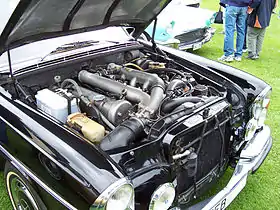Mercedes-Benz M100 engine
The Mercedes-Benz M100 engine was a 6.3 L (386.4 cu in)[1] single overhead cam V8 produced by Mercedes-Benz between 1963 and 1981. The successor to the M189 version of the company's venerated 3.0 L (183.1 cu in) straight-6 M186, it was introduced in the flagship Mercedes-Benz 600. In 1968, it was fitted to the high-performance Mercedes-Benz 300SEL 6.3 sports sedan. The engine was enlarged to 6.8 L (417 cu in) in 1975 for the Mercedes-Benz 450SEL 6.9 (1975-1981).
| Mercedes-Benz M100 engine | |
|---|---|
 | |
| Overview | |
| Manufacturer | Daimler-Benz |
| Production | 1963-1981 |
| Layout | |
| Configuration | Naturally aspirated V8 |
| Displacement |
|
| Cylinder bore |
|
| Piston stroke | 95 mm (3.74 in) |
| Block material | Cast iron |
| Head material | Aluminum |
| Valvetrain | SOHC |
| Compression ratio |
|
| Combustion | |
| Fuel system | Mechanical fuel injection |
| Management |
|
| Fuel type | Gasoline |
| Oil system | Dry sump |
| Cooling system | Water-cooled |
| Output | |
| Power output |
|
| Torque output |
|
The M100 featured a cast iron block, aluminum alloy heads, and aircraft-style sodium-filled valves operating against hardened valve seats. As in all Mercedes-Benz automobile engines, the crankshaft, connecting rods and pistons were forged instead of cast.
Each hand-built unit was bench-tested for 265 minutes, 40 of which were under full load. As introduced, it utilized a mechanical fuel injection system designed and built in-house by Daimler-Benz. The 6.8 L (6,834 cc) version used a Bosch K-Jetronic Continuous Injection System.
The 6.3 L power plant was conservatively rated at 250 PS (184 kW), with 503 N⋅m (371 lb⋅ft) of torque helping to compensate for the 2.82 to 1 final drive ratio necessary for sustained high-speed cruising.
In non-US trim, the 6.8 L engine produced 286 PS (210 kW) with 550 N⋅m (406 lb⋅ft) of torque. The North American version of it, introduced in 1977, was significantly less powerful at 250 PS (184 kW) and 488 N⋅m (360 lb⋅ft) of torque due to more stringent emissions control requirements.
The 6.9 L M100 used a "dry sump" engine lubrication system, which both enhanced longevity and reduced overall engine height. Originally developed for racing as a way to prevent engine oil foaming at high crankshaft RPMs, which in turn would create a serious drop in oil pressure, it allowed sustained high speeds at full engine power. The M100 system circulated a massive twelve litres of oil through the engine and a storage tank mounted inside the right front fender, as opposed to the usual four or five litres found in V8s with a standard oil pan and oil pump configuration. The dry sump system also had the benefit of extending the oil change interval to 12,500 mi (20,100 km). This, along with hydraulic valve lifters which required no adjusting and special cylinder head gaskets which eliminated the need for periodic retorquing of the head bolts, made the 6.8 nearly maintenance-free for its first 50,000 mi (80,000 km).
References
- Martin, Murilee (30 May 2009). "Engine Of The Day: Mercedes-Benz M100 V8". Jalopnik. Gizmodo Media Group. Retrieved 16 July 2017.